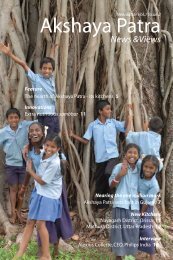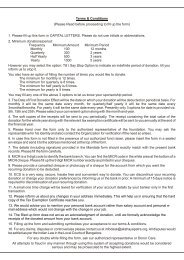The Top 100 NGOs 2013. - Akshaya Patra
The Top 100 NGOs 2013. - Akshaya Patra
The Top 100 NGOs 2013. - Akshaya Patra
Create successful ePaper yourself
Turn your PDF publications into a flip-book with our unique Google optimized e-Paper software.
1<br />
BRAC<br />
<strong>The</strong> agile gianT oF <strong>The</strong> DeveloPmenT worlD<br />
After landing at a more than<br />
respectable fourth place<br />
in our inaugural <strong>Top</strong> <strong>100</strong><br />
<strong>NGOs</strong> ranking, BRAC (formerly<br />
the Bangladesh Rural Advancement<br />
Committee) – the largest non<br />
government development organization<br />
on the planet – has claimed this<br />
year’s top spot. A member of the eradefining<br />
1970s wave of Bangladeshi<br />
microcredit and microfinance pioneers<br />
alongside the Grameen Bank and ASA,<br />
BRAC has since gone on to outpace<br />
its old counterparts and assume an<br />
unparalleled position in the crowded<br />
field of international development.<br />
From the perspective of our ranking<br />
criteria – impact, innovation and<br />
sustainability – BRAC ticks every box.<br />
While still involved in the microfinance<br />
space – to the tune of approximately $5<br />
billion – the organization has carefully,<br />
sPecial FeaTure sPecial FeaTure<br />
but steadily, diversified into a wide<br />
suite of activities, from agriculture<br />
and food security to education, legal<br />
aid, climate change risk reduction,<br />
livelihoods support and maternal and<br />
child health. Rather than spreading<br />
BRAC’s resources too thin, this strategy<br />
has instead remained faithful to<br />
founder Sir Fazle Hasan Abed’s vision<br />
of a holistic, sustainable approach to<br />
poverty reduction. Indeed, BRAC is in a<br />
unique position to use its microfinance<br />
base as a social platform to deliver<br />
innovative scaled up services aligned to<br />
a principled, rights-based philosophy.<br />
As we noted last year, BRAC is in<br />
many ways a microcosm of the entire<br />
international development sector in<br />
one organization, albeit gaining in<br />
independence from donor influence<br />
each year as it covers almost 80 percent<br />
of its $572 million operating budget<br />
through a burgeoning portfolio of<br />
<strong>The</strong> gloBal Journal + January & FeBruary 2013<br />
3<br />
hQ locaTion: BanglaDesh<br />
catalytic social enterprises – a clear<br />
trend positioning the organization in<br />
an enviable position of financial and<br />
programmatic sustainability.<br />
Yet rather than taking this as a cue<br />
to rest on its laurels, BRAC has at<br />
the same time used its considerable<br />
resources and in-house human capital<br />
to build an expansive and dedicated<br />
monitoring and evaluation apparatus,<br />
with positive flow on effects for the<br />
entire sector.<br />
Ultimately, BRAC has evolved into<br />
a giant of an NGO in a way that<br />
some could see as problematic – a<br />
non-public entity that touches the<br />
lives of more than 110 million people.<br />
Reassuringly, however, while size is not<br />
often an indication of quality, BRAC<br />
represents a welcome outlier and a<br />
continuing force for good at the<br />
global level.<br />
© Brac © Brac<br />
<strong>The</strong>gloBalJournal.neT<br />
40 41<br />
© Brac





